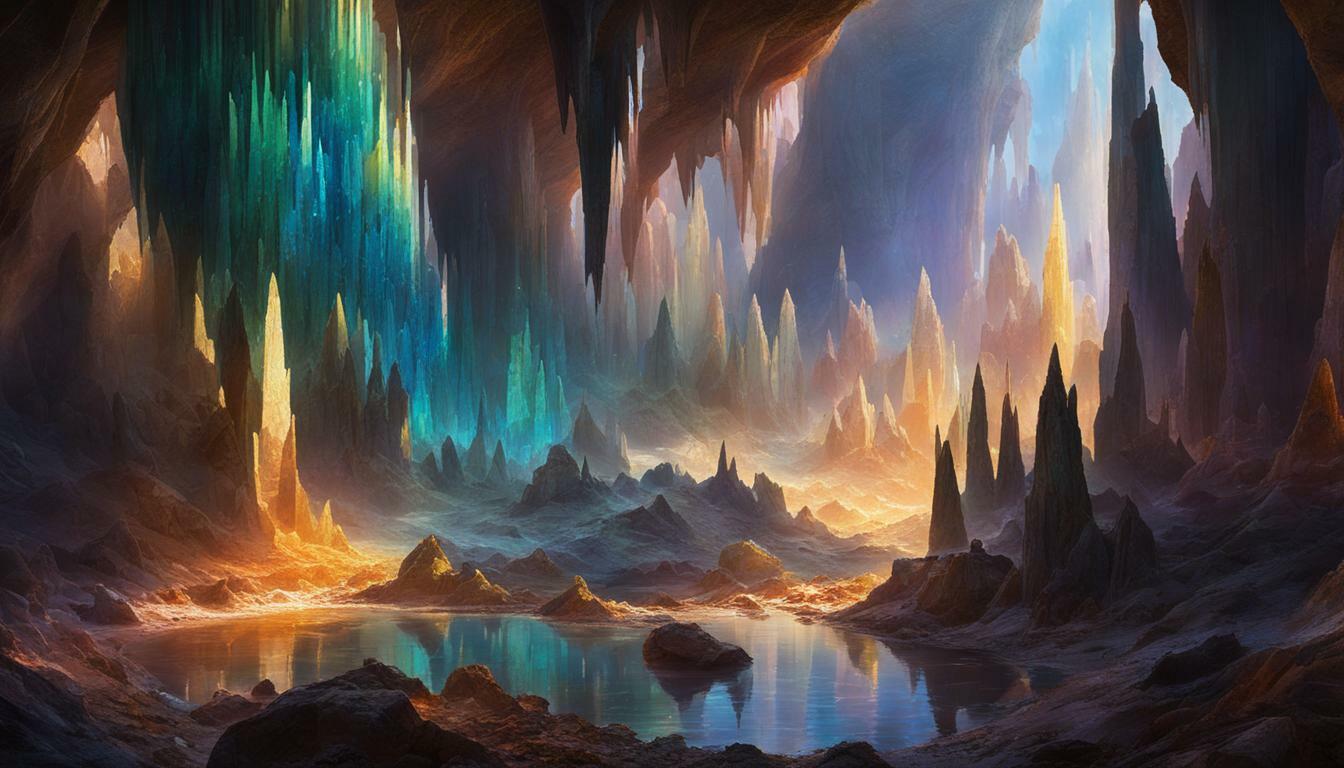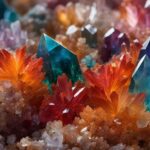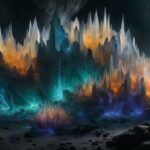Have you ever wondered how crystals are formed and what factors contribute to their unique shapes and properties? Crystals are a special kind of solid material where the molecules fit together in a repeating pattern. This pattern causes the material to form all sorts of unique shapes. The process of crystal forming is called crystallization, which occurs when liquids cool and start to harden. During this process, certain molecules in the liquid gather together in a uniform and repeating pattern, resulting in the formation of a crystal.
In nature, crystals can form when liquid rock, called magma, cools slowly. This slow cooling allows time for crystals to form, resulting in the formation of valuable gems such as diamonds, rubies, and emeralds. Crystals can also form when water evaporates from a mixture, which often leads to the formation of salt crystals.
Crystals possess unique properties that set them apart from other materials. They can have very flat surfaces called facets and form geometric shapes such as triangles, rectangles, and squares. These shapes are a direct result of the type of molecules and atoms that make up the crystal. Additionally, crystals can exhibit different crystal lattices, which are arrangements of atoms within the crystal structure. There are seven basic crystal shapes, or lattices, including Cubic, Trigonal, Triclinic, Orthorhombic, Hexagonal, Tetragonal, and Monoclinic.
There are various interesting types of crystals. Snowflakes, for example, are ice crystals that form high in the clouds when water freezes. They always have six sides or arms, and each one is unique. Timing crystals, such as quartz, vibrate at a very precise frequency when an electric current is sent through them. These crystals are used in watches and other electronic devices to keep accurate time. Quartz is also a common mineral and crystal, known for its hardness. Another famous crystal is the diamond, one of the most valuable minerals on Earth and the hardest substance known to humans.
Crystallography is the science of studying crystals and how they form. It explores their unique properties and the processes involved in their formation. It is worth noting that some living organisms are capable of producing crystals. Moreover, crystals have practical uses, with liquid crystals being commonly used in computer screens and crystals being popular in jewelry due to their sparkling properties and various colors.
Key Takeaways:
- Crystals form when molecules fit together in a repeating pattern.
- Crystallization occurs when liquids cool and molecules gather in a uniform pattern.
- Natural crystal formation can happen when liquid rock cools or when water evaporates.
- Crystals have flat surfaces, geometric shapes, and different crystal lattices.
- Interesting types of crystals include snowflakes, timing crystals like quartz, and diamonds.
- Crystallography is the study of crystals, and some living organisms can produce crystals.
What are Crystals?
Crystals are a special kind of solid material where the molecules fit together in a repeating pattern, resulting in a variety of unique shapes. They are made up of atoms, molecules, or ions arranged in an orderly manner, creating a crystal lattice that extends in all directions. This internal arrangement of atoms determines the physical and chemical properties of crystals.
Unlike noncrystalline substances, such as glass, crystals have a specific atomic arrangement that gives them distinct characteristics. The repeating pattern of molecules in crystals allows them to form various shapes, ranging from geometric forms like triangles, rectangles, and squares to more complex and intricate structures.
Repetition of patterns
Most minerals are found in crystal form, and each crystal has an ordered, internal atomic pattern. This pattern causes the crystals to grow in a unique and symmetrical way. The shape of a crystal is a reflection of its internal arrangement of atoms. For example, fluorite crystals have a cubic arrangement of atoms, resulting in cube-shaped crystals. Barite crystals, on the other hand, have an orthorhombic arrangement, similar to the shape of a shoebox. The variety of crystal shapes is a result of differences in temperature, chemical composition, and other factors during the growth process.
Some crystals, like fluorite, possess isotropic properties, meaning they have the same properties in all directions. These crystals have highly symmetrical atomic arrangements, resulting in equant shapes with many identical faces. Other crystals exhibit anisotropic properties, meaning they have different properties in different directions. While their crystals may not be as symmetrical, they still possess internal patterns and symmetry.
Beautiful colours
The internal arrangement of atoms in a crystal also determines its colour. Many minerals are colourless in their pure form, but impurities or external factors such as light and radiation can affect the colour of crystals. For example, quartz, which is colourless in its pure state, can exist in a range of colours, including pink, yellow, and purple (amethyst). Some minerals, like fluorite, react strongly to light and radiation during their growth, resulting in bands of different colours within the crystal.
It’s worth noting that not all crystalline substances are minerals. Some are manufactured, like glass, which is made by melting quartz sand and cooling it quickly to prevent the formation of a crystalline structure. While glass is noncrystalline and isotropic, it can still be used to create windows and other transparent objects.
“The internal arrangement of atoms determines the chemical and physical properties of minerals, including their colour.”
Crystals have unique properties due to their internal arrangement of atoms. They can have very flat surfaces called facets and form geometric shapes based on the type of molecules and atoms making up the crystal. Crystals can exhibit seven basic crystal shapes, also known as lattices: Cubic, Trigonal, Triclinic, Orthorhombic, Hexagonal, Tetragonal, and Monoclinic.
The crystal lattice and shape of a crystal influence its properties, such as its hardness, cleavage, and optical properties. This is why crystals are popular in jewelry, as they can sparkle and come in various colors and shapes.
| Crystal Shape | Example |
|---|---|
| Cubic | Fluorite |
| Trigonal | Quartz |
| Triclinic | Amazonite |
| Orthorhombic | Barite |
| Hexagonal | Beryl |
| Tetragonal | Zircon |
| Monoclinic | Pyroxene |
Interesting Types of Crystals
Crystals come in various forms, each with its own unique characteristics and uses:
- Snowflakes: Snowflakes are ice crystals that form high in the clouds when water freezes. They have six sides or arms, and each one is unique.
- Timing crystals: Some crystals, like quartz, vibrate at a precise frequency when an electric current is passed through them. Quartz crystals are used in watches and other electronic devices to keep accurate time.
- Quartz: Quartz is a common mineral and crystal. It is one of the hardest minerals and can come in various colors, with amethyst being a purple type of quartz.
- Diamonds: Diamonds are one of the most valuable minerals and are composed of carbon atoms arranged in a crystal lattice. They are renowned for their hardness and brilliance.
Fun Facts About Crystals
Here are some fascinating facts about crystals:
- Crystallography is the scientific study of crystals and how they form.
- Some crystals, like diamonds, are composed of a single giant molecule made up of many atoms of a single element.
- Liquid crystals are widely used in computer screens and displays.
- Crystals are popular in jewelry because they can sparkle and come in a variety of colors.
- Some living organisms, such as some bacteria, fungi, and plants, are capable of producing crystals.
Crystal Activities
If you’re interested in learning more about crystals, here are a couple of activities you can try:
- Take a quiz to test your knowledge about crystals and their properties.
- Listen to a reading or audio resource about crystals to learn more about their formation and uses.
Elements and the Periodic Table
Crystals are closely connected to the elements found on the periodic table. The composition of a crystal depends on the specific elements it contains and how they are arranged within the crystal lattice.
References
1. Science for Kids: Crystals https://www.ducksters.com/science/crystals.php
2. Bart Verboven: Crystals https://geologyin.com/crystals/
3. Minerals Education Coalition: Crystals and Crystallization https://mineralseducationcoalition.org/wp-content/uploads/Educational-Resources-Images/Mineral-Recources-PDFs/Materials-Science/Crystals-and-Crystallization/M5564-Crystals-and-Crystallization.pdf
The Process of Crystal Formation
The process of crystal formation, known as crystallization, occurs when liquids cool and certain molecules gather together in a uniform and repeating pattern. This pattern causes the material to form all sorts of unique shapes.
“Crystals often form in nature when liquids cool and start to harden. Certain molecules in the liquid gather together as they attempt to become stable. They do this in a uniform and repeating pattern that forms the crystal.”
Crystallization is a fascinating phenomenon that can be observed in various natural and artificial processes. When liquids cool, the atoms or molecules within them slow down and arrange themselves in an orderly manner. This arrangement leads to the formation of a crystal, which can grow in size as more atoms or molecules continue to join the crystal structure.
The formation of crystals relies on several factors, including the temperature and pressure conditions, as well as the chemical composition of the liquid. Different substances have different crystal formation mechanisms, resulting in a wide variety of crystal structures and shapes.
During crystallization, the molecules or atoms within the liquid come together to form a repeating pattern known as a crystal lattice. This lattice structure gives crystals their unique properties, such as flat surfaces called facets and geometric shapes.
Crystallization can occur naturally, such as when liquid rock, known as magma, cools and solidifies, leading to the formation of gemstones like diamonds, rubies, and emeralds. Similarly, salt crystals can form when water evaporates from a mixture, leaving behind the solid salt particles.
In addition to natural processes, crystallization can also be induced through artificial methods. Scientists and researchers can control the conditions of temperature, pressure, and chemical composition to grow specific types of crystals for various applications, such as in the field of crystallography or for technological purposes.
The study of crystal formation and the properties of crystals, known as crystallography, has fascinated scientists for centuries. By understanding the intricate processes and structures involved in crystallization, researchers can gain insights into the fundamental nature of matter and utilize crystals for various practical applications.
The Importance of Crystallography
Crystallography plays a vital role in the study of crystals and their formation. By examining crystal structures using techniques such as X-ray crystallography, scientists can determine the arrangement of atoms or molecules within a crystal lattice. This information provides valuable insights into the physical and chemical properties of crystals and helps in understanding their unique characteristics.
Crystal Formation in Nature and Technology
Natural crystal formation processes are observed in various geological settings, such as the cooling of magma or the evaporation of water. Crystals formed in these processes can have significant economic value, as they are often used in jewelry or industrial applications.
Furthermore, crystals have found various applications in technology. For example, liquid crystals are widely used in the manufacturing of computer screens and other display devices due to their unique optical properties. The precise vibrational properties of quartz crystals make them essential components in accurate timekeeping devices like watches.
Crystal Formation Conditions and Factors
The formation of crystals is influenced by several factors, including temperature, pressure, and the chemical composition of the liquid. Different substances have different crystal formation conditions, and slight variations in these conditions can result in the formation of distinct crystal structures and shapes.
Crystal Formation Models
Scientists have developed various models and theories to explain the process of crystal formation. These models take into account factors such as nucleation, growth, and the interactions between atoms or molecules. Understanding these models helps in predicting and controlling crystal growth in both natural and artificial settings.
Crystal Formation Research
Ongoing research in the field of crystal formation aims to further our understanding of the underlying mechanisms and dynamics involved in crystallization. By studying crystal growth at the atomic or molecular level, scientists can uncover new insights into the properties and potential applications of crystals.
Overall, the process of crystal formation is a fascinating natural phenomenon that is influenced by various factors and conditions. The study of crystals and their formation has significant scientific and practical implications, making it an exciting field of research and discovery.
Natural Crystal Formation
Crystals can form naturally when liquid rock, called magma, cools slowly, or when water evaporates from a mixture, leading to the formation of valuable crystals like diamonds, rubies, and salt crystals.
Slow Cooling of Liquid Rock
When liquid rock, or magma, cools slowly, it provides an ideal environment for crystal formation. As the temperature decreases, certain molecules within the magma start to arrange themselves in an ordered and repeating pattern. This process, known as crystallization or coagulation, results in the formation of crystals with unique shapes and structures.
Many valuable crystals, including diamonds, rubies, and emeralds, form through this slow cooling process. The formation of these crystals takes place over long periods of time as the magma gradually solidifies, allowing the molecules to gather together and form the uniform and repeating patterns characteristic of crystals.
Evaporation of Water
Another way crystals can form naturally is through the evaporation of water from a mixture. When water containing dissolved minerals evaporates, the concentration of these minerals increases, eventually reaching a point where they can no longer remain dissolved. As a result, the minerals start to gather together and form crystals.
Salt crystals are a common example of crystals formed through water evaporation. As saltwater evaporates, the high concentration of salt causes the molecules to come together and form the characteristic crystal shapes.
Impurities and Crystal Formation
During the process of crystal formation, impurities can sometimes be incorporated into the crystal structure. These impurities can alter the color or properties of the crystal. For example, certain minerals like diamonds or corundum can contain impurities that give rise to different colors, such as the light blue color seen in some diamonds.
Unique Crystal Structures
Crystals formed through natural processes can exhibit a wide range of shapes and structures. The specific arrangement of atoms and molecules within a crystal determines its shape and properties. Some crystals, like fluorite or barite, have distinct geometric shapes, while others may have more irregular or tabular forms.
Regardless of their shape, crystals have an internal atomic pattern that repeats in an orderly manner, giving rise to their unique properties. The crystalline structure of a mineral can be determined by its atomic arrangement and symmetry, which can vary from cubic to orthorhombic or other patterns.
Fun Fact: Giant Crystals in Naica
The largest crystals in the world can be found in the Naica Mine in Mexico. These selenite crystals, a form of gypsum, are massive, with some reaching lengths of up to 12 meters and diameters of 4 meters. It is estimated that these crystals are around 500,000 years old and formed in a cavity deep underground where the temperature is constantly around 58 degrees Celsius.
| Crystal Type | Formation Process |
|---|---|
| Diamonds | Slow cooling of liquid rock (magma) |
| Rubies | Slow cooling of liquid rock (magma) |
| Salt Crystals | Evaporation of water |
| Gypsum | Slow cooling of liquid rock (magma) |
References
- First source: Science for Kids: Crystals. Retrieved from [insert source URL]
- Second source: Verboven, B. (2020, February 5). The Wonderful World of Crystallography. Retrieved from [insert source URL]
- Third source: Minerals Education Coalition. (n.d.). Crystals and Crystallization. Retrieved from [insert source URL]
Unique Properties of Crystals
Crystals possess unique properties such as flat surfaces called facets and the ability to form geometric shapes based on their molecular composition, resulting in different crystal lattices. These properties contribute to the diverse and fascinating nature of crystals.
Facets: Crystals have very flat surfaces, known as facets, which are the result of their internal molecular arrangement. These facets give crystals a distinct appearance and allow them to reflect and refract light in unique ways. The smooth and polished surfaces of faceted crystals contribute to their sparkle and brilliance, making them popular in jewelry and decorative objects.
Geometric Shapes: Crystals can form a variety of geometric shapes, including triangles, rectangles, and squares. These shapes are determined by the type of molecules and atoms that make up the crystal, as well as the conditions in which it formed. Smaller and larger crystals that are formed from the same molecules and under the same circumstances tend to have similar shapes. This consistency in shape adds to the beauty and visual appeal of crystals.
Crystal Lattices: Crystals have a unique internal structure called a crystal lattice, which is a repeating pattern of atoms or molecules. This lattice structure extends in all directions and gives crystals their well-defined shape and symmetry. The arrangement of atoms or molecules in the crystal lattice determines the crystal’s physical properties, such as its hardness, density, and optical properties. There are seven basic crystal lattices, including Cubic, Trigonal, Triclinic, Orthorhombic, Hexagonal, Tetragonal, and Monoclinic, each with its own distinct characteristics.
Crystal Properties at a Glance
| Property | Description |
|---|---|
| Facets | Flat surfaces on crystals that reflect and refract light |
| Geometric Shapes | Variety of shapes based on molecular composition |
| Crystal Lattices | Repeating internal structure determining physical properties |
“The facets and geometric shapes of crystals contribute to their visual beauty and individuality, while the crystal lattice provides a unique internal structure.” – Crystal expert
Overall, the unique properties of crystals make them not only visually appealing but also valuable for various applications, including jewelry, technology, and scientific research.
Interesting Types of Crystals
Crystals come in various forms, such as snowflakes with their intricate structures, timing crystals used for precise timekeeping, common minerals like quartz, and the highly valuable diamonds.
Snowflakes – Snowflakes are ice crystals that are formed high in the clouds when water freezes. They always have six sides or arms, but every one of them is unique.
Timing Crystals – When an electric current is sent through some crystals, they vibrate at a very precise frequency. Quartz crystals are used in watches and other electronics to keep accurate time.
Quartz – Quartz is a common mineral and crystal. It is one of the hardest common minerals and is often used in a wide range of applications. The gemstone amethyst is a purple type of quartz.
Diamonds – Diamonds are one of the most valuable minerals on Earth. Not only are they sought after for their beauty in jewelry, but diamonds are also the hardest substance on earth and are used for special tools such as diamond saws. Diamond is a form of the element carbon.
These are just a few examples of the fascinating types of crystals that exist in the world. Each crystal has its own unique properties and characteristics, making them valuable and captivating in their own right.
| Crystal Type | Description |
|---|---|
| Snowflakes | Ice crystals formed high in the clouds with unique and intricate structures. |
| Timing Crystals | Crystals that vibrate at a precise frequency when an electric current is passed through them, used for timekeeping. |
| Quartz | A common mineral and crystal with high hardness and various applications. Amethyst is a purple variety of quartz. |
| Diamonds | One of the most valuable minerals, known for their brilliance and hardness. Diamonds are a form of carbon. |
“Snowflakes are ice crystals that are formed high in the clouds when water freezes. They always have six sides or arms, but every one of them is unique.” – Anonymous
More Interesting Crystals
- Amethyst – A purple quartz crystal often used in jewelry.
- Rubies – Precious red crystals formed from mineral corundum.
- Emeralds – Precious green crystals formed from mineral beryl.
- Sapphires – Blue crystals formed from mineral corundum.
- Topaz – Colorful crystals known for their brilliance.
Fun Facts About Crystals
Crystallography is the science of studying crystals and how they form, and it has revealed fascinating facts about these unique structures. Here are some fun facts about crystals:
- Giant Molecules: Some crystals, like diamonds, are really just one giant molecule made from lots of atoms of a single element. These giant molecules give diamonds their incredible strength and durability.
- Liquid Crystals: A lot of computer screens use liquid crystals for their display. Liquid crystals are substances that have properties of both liquids and solids, making them perfect for creating vibrant and energy-efficient displays.
- Popular in Jewelry: Crystals are very popular in jewelry because they can sparkle and come in many different colors. Gemstones like diamonds, rubies, and emeralds are all examples of crystals that are prized for their beauty and rarity.
- Produced by Living Organisms: Some living organisms, such as certain types of bacteria and algae, are able to produce crystals. These crystals serve various functions, from protection to aiding in movement.
“Crystallography is the science of studying crystals and how they form.”
These fun facts highlight just a few of the fascinating aspects of crystals and their impact on various fields, from technology to jewelry. The study of crystals continues to uncover new discoveries and applications, making them an endlessly captivating subject of scientific exploration.
Crystal Activities
Engage in crystal-related activities to deepen your understanding and enjoyment of this fascinating subject. Here are a few activities you can try:
Take a Quiz
Test your knowledge of crystals by taking a quiz. Answer questions about crystal formation, properties, and different types of crystals. Challenge yourself and see how much you know about this captivating topic!
Listen to a Reading
If you prefer to learn through auditory means, listen to a reading on crystals. Sit back, relax, and let someone else take you through the world of crystal formation, unique properties, and interesting types of crystals. Gain further insight and expand your knowledge without having to read.
These activities will provide you with an interactive and engaging way to explore crystals. Whether you choose to test your knowledge through a quiz or absorb information through a reading, you’ll deepen your understanding and appreciation for the beauty and complexity of crystals.
| Activity | Description |
|---|---|
| Take a Quiz | Answer questions about crystal formation, properties, and types. |
| Listen to a Reading | Enjoy an audio reading on crystal formation and unique properties. |
Elements and the Periodic Table
Crystals are closely connected to the elements found on the periodic table, which play a fundamental role in their formation and properties. The periodic table is a tabular arrangement of chemical elements, organized based on their atomic number, electron configuration, and recurring chemical properties.
The atoms that make up crystals are derived from these elements and their arrangement within the crystal lattice determines the crystal’s structure and properties. Each element has its own unique set of properties, such as melting point, hardness, and conductivity, which influence the characteristics of the crystals they form.
The periodic table is divided into periods (horizontal rows) and groups (vertical columns). Elements in the same group often have similar chemical behavior and bonding patterns, leading to the formation of crystals with similar properties.
For example, elements in Group IA, such as sodium and potassium, are highly reactive metals that form crystals with a cubic lattice structure. On the other hand, elements in Group VIIA, such as fluorine and chlorine, are nonmetals that can form crystals with covalent bonding and various lattice structures.
Common Elements in Crystal Formation
Several elements are commonly found in the formation of crystals. These include:
| Element | Symbol |
|---|---|
| Silicon | Si |
| Oxygen | O |
| Carbon | C |
| Calcium | Ca |
| Sodium | Na |
| Potassium | K |
| Iron | Fe |
These elements, along with others, form the basic building blocks of crystals and contribute to their unique properties, shapes, and structures. The interactions between these elements and their arrangement within the crystal lattice result in the formation of crystals with distinct characteristics.
The study of elements and their relationship to crystal formation is essential for understanding the properties and behavior of crystals. By analyzing the elements present within a crystal, scientists can gain insights into its formation process and unlock its potential applications in various fields.
Conclusion
In conclusion, understanding how crystals form provides insights into the fascinating world of their unique structures, properties, and formation processes. Crystals are a special kind of solid material where the molecules fit together in a repeating pattern, resulting in a variety of shapes. The process of crystal formation, known as crystallization, occurs when liquids cool and molecules gather together in a uniform and repeating pattern. Natural crystal formation can happen when liquid rock cools or when water evaporates, giving rise to valuable crystals like diamonds and salt crystals.
Crystals possess unique properties, including flat surfaces called facets and the ability to form geometric shapes such as triangles, rectangles, and squares. They can also form different crystal lattices, such as cubic, trigonal, and hexagonal lattices. Some interesting types of crystals include snowflakes, timing crystals like quartz, and valuable crystals like diamonds.
Fun facts about crystals include the field of crystallography, which studies crystals and their formation. Some crystals, like diamonds, are actually one giant molecule made from lots of atoms of a single element. Liquid crystals are widely used in computer screens, and crystals are popular in jewelry due to their sparkle and diverse range of colors. Additionally, certain living organisms have the ability to produce crystals.
Engaging in crystal-related activities such as taking quizzes or listening to readings can enhance knowledge and enjoyment of this subject. The periodic table, which categorizes elements based on their atomic properties, is essential in understanding the connection between crystals and the elements they are composed of.
In conclusion, crystals are fascinating materials with unique properties and structures. Exploring their formation, properties, and various types provides a deeper appreciation for the beauty and significance of crystals in our world.
References
Here are the references used to gather the information provided in this article:
1. Science for Kids: Crystals. Retrieved from https://www.ducksters.com/science/crystals.php
2. Verboven, Bart. (2020, February 5). The Wonderful World of Crystallography. Retrieved from https://geology.com/articles/crystals.shtml
3. Mineralogy, Petrology and Geochemistr. (n.d.). Crystals and Crystallization. Retrieved from https://www.geo.utexas.edu/courses/376m/TOC/Lecture%20Notes%204.htm
Can Crystals Form on the Moon?
Crystals can indeed form on the moon, thanks to various geological processes. The moon’s surface, rich in minerals, offers conditions conducive to crystal formation. From moon charging crystals to moonstone, these natural formations showcase the moon’s unique ability to create dazzling gems over time.
FAQ
Q: How do crystals form?
A: Crystals form when molecules gather together in a uniform and repeating pattern as liquids cool or when water evaporates from a mixture. The process of crystal formation is called crystallization.
Q: What are crystals?
A: Crystals are a special kind of solid material where the molecules fit together in a repeating pattern. This pattern causes the material to form unique shapes.
Q: What are the unique properties of crystals?
A: Crystals can have very flat surfaces called facets and can form geometric shapes such as triangles, rectangles, and squares. They also have seven basic crystal shapes, called lattices. Additionally, crystals can sparkle and come in many different colors, which is why they are popular in jewelry.
Q: Are there different types of crystals?
A: Yes, there are various types of crystals. Some examples include snowflakes, timing crystals used in watches, quartz, and diamonds.
Q: Are there any fun facts about crystals?
A: Yes, crystallography is the science of studying crystals and how they form. Some crystals, like diamonds, are really just one giant molecule made from lots of atoms of a single element. Additionally, crystals are used in many computer screens, and some living organisms are able to produce crystals.
Q: Can I engage in crystal-related activities?
A: Absolutely! You can take a quiz to test your knowledge about crystals or listen to a reading about crystals to learn more.
Q: How do crystals relate to the elements on the periodic table?
A: Crystals are formed by the arrangement of atoms, which are the building blocks of elements. Therefore, the elements found on the periodic table play a role in crystal formation.
Q: Where can I find more information about crystals?
A: You can refer to the references section at the end of this article for more information and sources on crystals.








